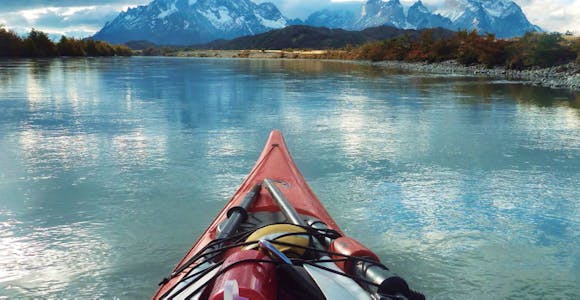
What to do in Torres del Paine
Torres del Paine has a host of activities on offer, from classic hikes to tracking pumas. Explore on horseback, mountain bike or even paddle your way to a glacier.
Discover MoreDeep roots in Patagonia: We are ex-guides, tour leaders, outdoor enthusiasts, & adventurers.
We’ve got our feet on the ground: Impartial advice, a bespoke service, and at no extra cost.
For the ends of the Earth: Sustainability is more than our carbon footprint (but we’re reducing that too).

When you visit Torres del Paine will have a big impact on how you experience the national park. While many people are drawn to the long days of summer, the shoulder seasons of spring and autumn offer a quieter hiking experience, while snowy winters bring their own reward.
If you can go in the off season, I would highly recommend that to avoid the crowds. Read the full review
Travelled: February 2024
David Simonic - USA
The weather can change every 15 minutes and provides uniqueness all the time. Read the full review
Travelled: December 2022
Spencer Hess - USA
Mid-October was a good time to go because there were less people than there will be in November, so I was told. I would much prefer to be cold and then work and dress to heat up than have to find a way to cool down if I was too hot. Read the full review
Travelled: October 2022
Anne France - USA
Spring weather is very erratic. Hiking poles are very helpful. Good rain gear and waterproof hiking boots are essential. Prepare to be cold and damp in the spring. If you plan to hike, prepare physically before the journey. Read the full review
Travelled: October 2022
Brad Pontius - USA
April trips can be cold - below freezing at night, but 1 layer weather with sun in the afternoon. Read the full review
Travelled: April 2022
Seth Pound - USA
The view and hike were amazing, the 1000s of people hiking it were not. But this is to be expected for such an iconic landmark. Read the full review
Travelled: February 2022
Gina Capozzi - USA
On the first day of our trek, we were turned away by the rangers less than 1km from the Torres viewpoint because it was snowing so hard! It was disappointing to not see the towers but being caught in a summer snowstorm in Patagonia will be something we will never forget. Read the full review
Travelled: January 2022
Robert Gallagher - USA
The weather is very variable! But don't worry about it as the scenery is amazing in all weathers. Read the full review
Travelled: February 2018
Rod & Olwyn Dawson - United Kingdom
Whether it was snowy, rainy or a beautiful day full of sunshine, we loved every minute of the W trek. Read the full review
Travelled: December 2017
Craig Hobin - Brazil
Weather: Days tend to be mild – perfect for hiking, though evenings and mornings still carry a cold winter’s edge. The wind is picking up with gusts bringing sudden chills, so you’ll still need to dress warmly in the day.
Daylight: There are around 15 hours of daylight, increasing as the month goes on, so you can really maximise the long days spent out exploring.
Advantages: November is the shoulder season, so hotel rates will be lower.The park is relatively quiet so you can take your time on the trail getting close to nature and soaking up the scenery.
Things to consider: It’s spring, but it can still get very cold at times, especially with the windchill. Wrap up warm with lots of layers.
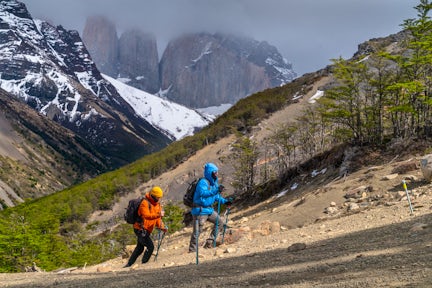
October in Torres del Paine
Weather: The wind really starts to picks up in November, however that's more than outweighed by the opportunity for higher temperatures, which can reach around 32F (16C) during the day
Daylight: With up to 16 hours of daylight the park really feels like it's heading into summer.
Advantages: With the season starting to get into full swing there are more wildflowers in bloom and more ways to the park by bike, kayak, or on horseback. The fishing season also begins.
Things to consider: Torres del Paine gets increasingly busy towards the end of the month as the high season starts to begin.
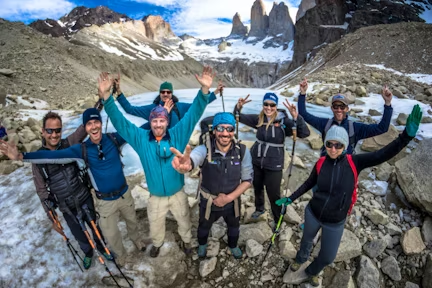
November in Torres del Paine
Weather: With temperatures up to 68F (20C) it can feel warm during the day, especially if you're trekking, but the summer winds can blow very strongly.
Daylight: Patagonia' longest day is in December, with an amazing 18 hours of daylight.
Advantages: Take your time on the trails and enjoy daylight long into the evening. Warm temperatures mean more comfortable hiking even in the strong winds.
Things to consider: Torres del Paine is at its busiest, with crowded hiking trails and accommodation and campsites booked up far in advance (see our guide on when to book your Patagonia trip for more).
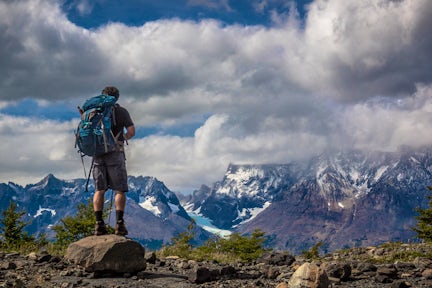
December in Torres del Paine
Weather: Temperatures are at their warmest, around 66F (19C) during the day but still drop to 45F (7C) at night. The wind really picks up, be prepared to brace hard on some of the mountain passes.
Daylight: 17 hours of daylight means long days out exploring, and soaking up the views long into the evening.
Advantages: Warm days and mild nights. All the adventure sport options are available, so you can experience the park at its fullest.
Things to consider: This is peak high season and the park will be very busy. Demand for accommodation outweighs supply, so book far in advance, especially if you're after a room in some of the more exclusive accommodation. Local tourism is also at its highest.
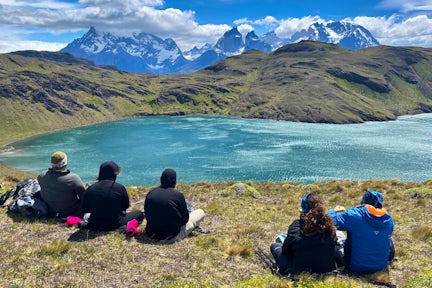
January in Torres del Paine
Weather: One of the warmest months of the year, with temperatures reaching over 68F 920C). If the sun is shining you might trek in shorts and a t-shirt, but this is still Patagonia, so you'll still to bing a raincoat and warm layers even on a clear day.
Daylight: Days are shortening, but you'll get around 14 hours of light, so take your time out hiking and enjoy daylight into the evening.
Advantages: This is one of the best months to avoid the rain. Wildlife is likely to be out, taking advantage of the warmth and long days.
Things to consider: The park will still be busy, and some of the trails may be a little worse for wear after a busy season. Availability is likely to be low, so book far in advance.
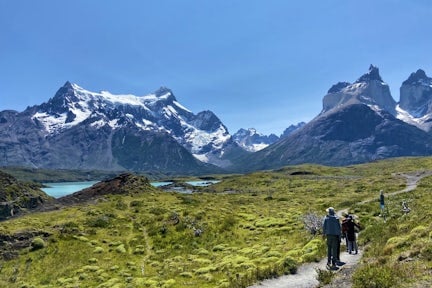
February in Torres del Paine
Weather: Although the wind is dying down and the temperatures are becoming milder, the weather is still unpredictable. Be prepared for sunshine, rain and wind on your hikes.
Daylight: Days are getting shorter, but with around 12 to 13 hours of daylight you'll still have a full day for your hike.
Advantages: With the colours at their most beautiful and the park beginning to quieten down, this is one of the best times of year to hike the more popular trails. Head out on the W Trek or the O Circuit.
Things to consider: The crowds only begin to drop off properly at the end of March, so plan to go later in the month if you're looking for solitude on your hikes.
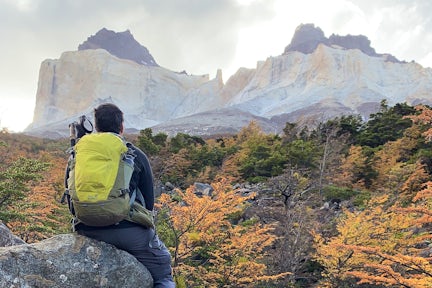
March in Torres del Paine
Weather: The air is clear and crisp, with temperatures settling between 37–55F (3–13C). Torrential rain, bright sunshine and buffeting wind can all make an appearance within a matter of hours.
Daylight: With 11 hours of daylight the days definitely feel shorter, but the long colourful sunsets are a wonder in themselves.
Advantages: Hotels remain open and will have higher availability due to fewer people being in the park. The hiking trails are significantly quieter.
Things to consider: By late April some transport and accommodation becomes reduced. If you're doing the W Trek or the O Circuit Trek you'll need to plan your overnight stops carefully in advance.
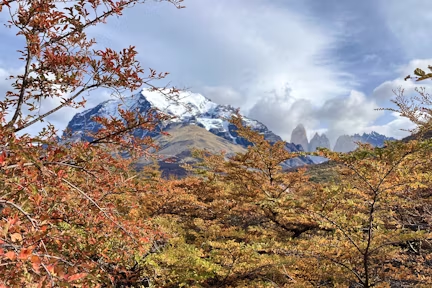
April in Torres del Paine
Weather: Temperatures continue to drop, Nights are especially cool with temperatures touching freezing for the first time. This is one of the highest months for rainfall, with a strong chance of snow.
Daylight: With only around nine hours of sunlight, the days will feel short, giving much less opportunity to take your time on the trails.
Advantages: The park is far quieter in May, as it settles into low season. You're likely to have the trails to yourself, to enjoy the flora and fauna at leisure.
Things to consider: Some services will be reduced, and refugios and hotels may be closed. Plan ahead, especially if you are planning a multi-day hike.
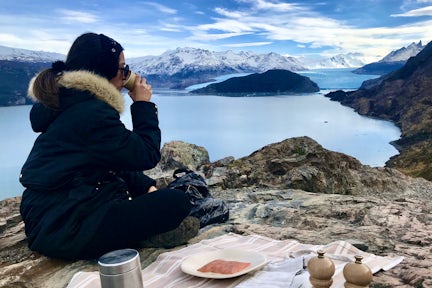
May in Torres del Paine
Weather: Lowest temperatures of the year, be prepared for it to drop below freezing at night and not climb much above 41F (5C), However, winds are at their lowest, with little more than gentle breezes.
Daylight: The shortest month of the year, with barely nine hours of daylight. You'll need to be organised and fit to get your hikes in.
Advantages: There are completely empty trails, beautiful snowscapes and a good chance of seeing pumas as they come down from the mountains to hunt.
Things to consider: Accommodation choices are very limited, and you'll need to be flexible with your plans if the weather turns bad.
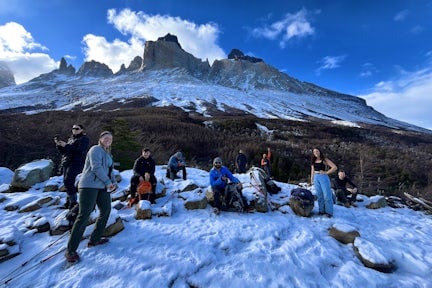
June in Torres del Paine
Weather: Temperatures are still hovering around freezing point with a strong chance of snow. Wind speeds are low.
Daylight: Days slowly begin to lengthen, with up to ten hours of daylight
Advantages: You'll have the park almost to yourself, and the photography opportunities are superb as the mountains are cloaked in snow.
Things to consider: Excursions are limited, and snowstorms may thwart your plans, so you'll need to be flexible. Plan ahead to get in and out of the park and also where you'll stay - transport and accommodation are both limited.
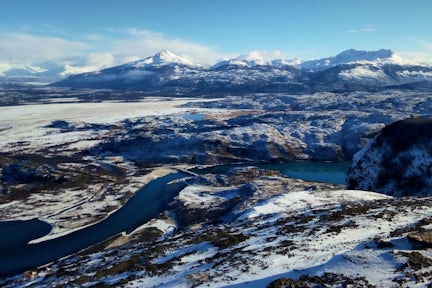
July in Torres del Paine
Weather: Snow is likely, and temperatures are unlikely to rise much above 45F (5C) degrees. Wrap up warm and make sure you're fully prepared to spend your days out in the snow.
Daylight: The hours of daylight are slowly creeping up, with nearly 11 hours as the month progresses.
Advantages: Beautiful snowscapes give a good chances of seeing pumas, which come down from the mountains over winter. The park is quiet and you'll feel truly out in the wilderness.
Things to consider: Services are still limited, so plan ahead for your accommodation and travel. Be prepared for the cold weather and to change plans if the weather changes suddenly.
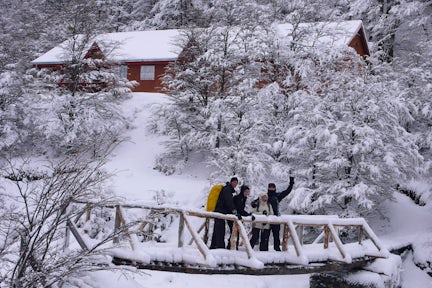
August in Torres del Paine
Weather: Spring is on its way, but there's still a nip in the air. There are remnants of the winter snows, and temperatures can plummet at night. Be prepared for rain, snow, sun and wind.
Daylight: The days are starting to properly lengthen after winter, and by the end of September you'll have 12 hours of daylight.
Advantages: As trails reopen after winter you'll be some of the first people back hiking that haven't been trodden on for a whole season. The park is quiet and slowly beginning to blossom.
Things to consider: Services in the park are still reduced, so you'll need to plan ahead. Catamarans only operate on certain days, and buses across the border to Argentina can be irregular and slow. Hotels, estancias and refugios begin to reopen mid-month.
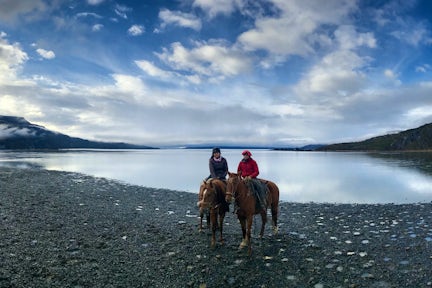
September in Torres del Paine

Torres del Paine has a host of activities on offer, from classic hikes to tracking pumas. Explore on horseback, mountain bike or even paddle your way to a glacier.
Discover More
Torres del Paine’s mountains and plains offer a spectacular backdrop for incredible wildlife encounters, from puma tracking to watching condors soaring on the thermals.
Discover More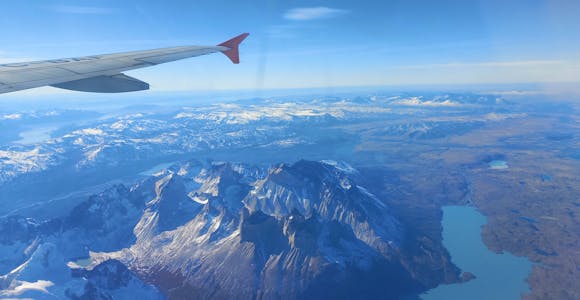
Whether you’re travelling from Santiago, Los Glaciares or beyond, Torres del Paine National Park is easy to get to from across Patagonia.
Discover More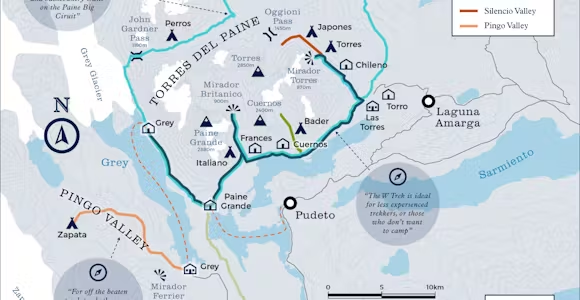
Maps of Torres del Paine National Park. Find the key routes and landmarks, and choose the best maps for trekking.
Discover MoreWe'll spend some time listening to your aspirations, then discuss the kind of experience that might suit you.
Next we'll discuss the options, shortlist the best trips for you and present you our impartial recommendations.
We'll place a 24 hour hold on your preferred option - without obligation - whilst we talk through the details.
This website uses cookies to ensure you get the best experience on our website. Privacy policy